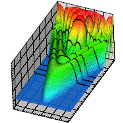Department of Physics and Astronomy: Publications and Other Research

Anthony F. Starace Publications
Document Type
Article
Date of this Version
7-17-2017
Citation
PHYSICAL REVIEW A 96, 013405 (2017)
Abstract
Two-armed helical vortex structures are predicted in the two-electron momentum distributions produced in double photoionization (DPI) of the He atom by a pair of time-delayed elliptically polarized attosecond pulses with opposite helicities. These predictions are based upon both a first-order perturbation theory analysis and numerical solutions of the two-electron, time-dependent Schrödinger equation in six spatial dimensions. The helical vortex structures originate from Ramsey interference of a pair of ionized two-electron wave packets, each having a total angular momentum of unity, and appear in the sixfold differential DPI probability distribution for any energy partitioning between the two electrons. The vortex structures are exquisitely sensitive to the time delay between the two pulses, their relative phase, their ellipticity, and their handedness; moreover, they occur in a variety of electron detection geometries. However, the vortex structures only occur when the angular separation β = cos−1( ˆp1 · ˆp2) between the electron momenta p1 and p2 is held fixed. The vortex structures can also be observed in the fourfold differential DPI probability distribution obtained by averaging the sixfold differential probability over the emission angles of one electron. Such kinematical vortices are a general phenomenon that may occur in any ionization process, initiated by two time-delayed short pulses with opposite ellipticities, for particular detection geometries.
Included in
Atomic, Molecular and Optical Physics Commons, Elementary Particles and Fields and String Theory Commons, Plasma and Beam Physics Commons


Comments
Copyright 2017 American Physical Society. Used by permission.